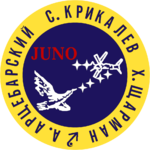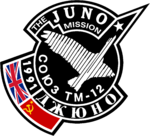Project Juno: Difference between revisions
patch added |
m Filled in 2 bare reference(s) with reFill 2 |
||
| (41 intermediate revisions by 32 users not shown) | |||
| Line 1: | Line 1: | ||
{{short description|Private British space programme}} |
|||
{{Use dmy dates|date=March 2015}} |
|||
{{Use British English|date=March 2015}} |
|||
[[File:Soyuz-tm12.png|right|150px|Mission patch for Project Juno.]] |
[[File:Soyuz-tm12.png|right|150px|Mission patch for Project Juno.]] |
||
[[File:Soyuz_TM-12_patch.png|right|150px|Mission patch for Project Juno.]] |
|||
'''Project Juno''' was a |
'''Project Juno''' was a privately funded campaign which selected [[Helen Sharman]] to be the first [[Briton]] in space. |
||
As the United Kingdom |
As the United Kingdom did not, at that time, have a [[human spaceflight]] programme (until the UK joined the human spaceflight elements of [[ESA]]'s exploration programme in December 2012,<ref>{{cite web |url=https://www.gov.uk/government/news/uk-secures-1-2-billion-package-of-space-investment |title=UK secures £1.2 billion package of space investment |author=<!--Not stated--> |date=21 November 2012 |website=Department for Business, Innovation & Skills |access-date=30 March 2019 |quote=}}</ref> which led to [[Tim Peake]]'s [[European Space Agency|ESA]] mission in 2015), a private consortium was formed to raise money to pay the [[Soviet Union]] for a seat on a [[Soyuz programme|Soyuz]] mission to the [[Mir]] [[space station]]. The Soviet Union had recently flown [[Toyohiro Akiyama]], a [[Japan]]ese [[journalist]], under a similar arrangement. |
||
==Selection== |
|||
A call for applicants was publicized in the UK (one ad read "Astronaut wanted. No experience necessary"<ref>http://www.scenta.co.uk/scenta/features.cfm?cit_id=94123&FAArea1=customWidgets.content_view_1</ref>), leading to 13,000 applications. Juno selected four candidates to train in the Soviet Union: |
|||
A call for applicants was publicized in the UK (one ad read "Astronaut wanted. No experience necessary"<ref>{{cite news|url=https://www.theguardian.com/science/2005/jul/01/spaceexploration.research|title=Space, the final frontier |first=Vivienne |last=Parry| date=1 July 2005| newspaper=The Guardian}}</ref>), leading to 13,000 applications. Juno selected four candidates to train in the Soviet Union:<ref>{{cite news|url=https://www.newspapers.com/clip/44570923/the_observer/|title=Lost in Space|newspaper=The Observer|location=London, England|date=May 5, 1991|via=Newspapers.com|page=32}}</ref> |
|||
* Gordon Brooks ([[Royal Navy]] physician, then 33) |
* Gordon Brooks ([[Royal Navy]] physician, then 33) |
||
* Major Timothy Mace ([[Army Air Corps (United Kingdom)|Army Air Corps]], 33) |
* Major Timothy Mace ([[Army Air Corps (United Kingdom)|Army Air Corps]], 33) |
||
* Clive Smith ([[Kingston University |
* Clive Smith ([[Kingston University]] lecturer, 27) |
||
* [[Helen Sharman]] (food technologist, 26) |
* [[Helen Sharman]] (food technologist, 26) |
||
Eventually Mace and Sharman were selected to continue full-time training at Star City. After learning Russian and familiarising themselves with the science programme, Smith and Brooks were employed to teach the other two how to perform the experiments and then to conduct them in a life sized mock up of Mir for live media during the mission. |
|||
Eventually Mace and Sharman were the two finalists, and Sharman was chosen for the flight with Mace as her backup. |
|||
==Funding== |
|||
The cost of the flight was to be funded by various innovative schemes, including sponsoring by private British companies and a lottery system. Corporate sponsors included [[British Aerospace]], [[Memorex]], and [[Interflora]], and television rights were sold to [[ITV]]. |
The cost of the flight was to be funded by various innovative schemes, including sponsoring by private British companies and a lottery system. Corporate sponsors included [[British Aerospace]], [[Memorex]], and [[Interflora]], and television rights were sold to [[ITV Network|ITV]]. |
||
The flight cost £7 million.<ref>{{cite news|url=https://www.newspapers.com/clip/44442056/chicago_tribune/|title=Brits in Space|newspaper=Chicago Tribune|location=Chicago, Illinois|date=May 30, 1990|via=Newspapers.com|page=5-7|last1=MacLeod|first1=Alexander}}</ref> |
|||
| ⚫ | Ultimately the Juno consortium failed to raise the entire sum, and the Soviet Union considered |
||
| ⚫ | Ultimately the Juno consortium failed to raise the entire sum, and the Soviet Union considered cancelling the mission. However [[Mikhail Gorbachev]] directed the mission to proceed at Soviet cost.<ref>Cosmonauts Exhibition, Science Museum, London, 2015</ref> The ambitious microgravity experiments originally planned were dropped when time ran out for sending required equipment on an automated 'Progress' flight. Helen did perform experiments designed by British schools that could be done with existing equipment aboard Mir along with a British microbiology screening investigation taken over by the Russians. |
||
Sharman was launched aboard [[Soyuz TM-12]] on 18 May 1991, and returned aboard [[Soyuz TM-11]] on 26 May 1991. |
|||
==Flight and after== |
|||
Sharman was launched aboard [[Soyuz TM-12]] on 18 May 1991,<ref>{{cite news|url=https://www.newspapers.com/clip/44443574/tallahassee_democrat/|title=Briton Travels in Space|newspaper=Tallahassee Democrat|location=Tallahassee, Florida|date=May 19, 1991|page=8A|via=Newspapers.com|agency=Associated Press}}</ref> and returned aboard [[Soyuz TM-11]] on 26 May 1991. |
|||
Both Sharman and Mace were candidates but not selected in the 1992 and 1998 [[European Space Agency]] selection rounds for its astronaut corps. Brooks was also put forward for the European Astronaut Corps in 1982, but dropped out when employed on AI systems elsewhere.<ref>{{Cite web|url=http://www.spacefacts.de/english/bio_cand.htm|title=Astronaut and Cosmonaut Candidates|website=www.spacefacts.de}}</ref> Mace did not fly in space, but married the daughter of [[cosmonaut]] [[Vitali Zholobov]]. He was later the [[helicopter]] pilot for [[President of South Africa]] [[Nelson Mandela]].<ref>{{Cite web|url=http://www.spacefacts.de/bios/international/english/mace_timothy.htm|title=Cosmonaut Biography: Timothy Mace|website=www.spacefacts.de}}</ref> He died in September 2014 from cancer.<ref>{{cite web|title=Tim Mace|url=http://www.fai.org/ipc-news/38664-tim-mace|website=FAI|accessdate=20 February 2016|url-status=dead|archiveurl=https://web.archive.org/web/20160306150940/http://www.fai.org/ipc-news/38664-tim-mace|archivedate=6 March 2016|df=dmy-all}}</ref> |
|||
Both Sharman and Mace were candidates but not selected in the 1992 and 1998 [[European Space Agency]] selection rounds for its astronaut corps. Mace did not fly in space, but married the daughter of [[cosmonaut]] [[Vitali Zholobov]]. He later was the [[helicopter]] pilot for [[President of South Africa]] [[Nelson Mandela]].<ref>[http://www.spacefacts.de/bios/international/english/mace_timothy.htm spacefacts.de]</ref> |
|||
==See also== |
==See also== |
||
*[[British National Space Centre]] |
*[[British National Space Centre]] |
||
| Line 31: | Line 41: | ||
* [http://news.bbc.co.uk/onthisday/low/dates/stories/may/18/newsid_2380000/2380649.stm BBC article] |
* [http://news.bbc.co.uk/onthisday/low/dates/stories/may/18/newsid_2380000/2380649.stm BBC article] |
||
*[http://www.spacefacts.de/bios/international/english/mace_timothy.htm Spacefacts bio of Timothy Mace] |
*[http://www.spacefacts.de/bios/international/english/mace_timothy.htm Spacefacts bio of Timothy Mace] |
||
*[http://www.portsmouth.co.uk/news/remember-flash-gordon-the-astro-not-1-7112633 Article about Gordon Brooks and Juno] |
|||
*[https://g3xwh.com JUNO Amateur Radio Contacts with Schools] |
|||
{{DEFAULTSORT:Juno, Project}} |
|||
{{space-stub}} |
|||
[[Category:Human spaceflight programs]] |
|||
[[Category: |
[[Category:Science and technology in the United Kingdom]] |
||
[[Category:Science and technology in the United Kingdom|Juno, Project]] |
|||
[[Category:Russia–United Kingdom relations]] |
[[Category:Russia–United Kingdom relations]] |
||
[[Category:Soviet Union–United Kingdom relations]] |
[[Category:Soviet Union–United Kingdom relations]] |
||
Latest revision as of 19:26, 28 November 2023


Project Juno was a privately funded campaign which selected Helen Sharman to be the first Briton in space.
As the United Kingdom did not, at that time, have a human spaceflight programme (until the UK joined the human spaceflight elements of ESA's exploration programme in December 2012,[1] which led to Tim Peake's ESA mission in 2015), a private consortium was formed to raise money to pay the Soviet Union for a seat on a Soyuz mission to the Mir space station. The Soviet Union had recently flown Toyohiro Akiyama, a Japanese journalist, under a similar arrangement.
Selection[edit]
A call for applicants was publicized in the UK (one ad read "Astronaut wanted. No experience necessary"[2]), leading to 13,000 applications. Juno selected four candidates to train in the Soviet Union:[3]
- Gordon Brooks (Royal Navy physician, then 33)
- Major Timothy Mace (Army Air Corps, 33)
- Clive Smith (Kingston University lecturer, 27)
- Helen Sharman (food technologist, 26)
Eventually Mace and Sharman were selected to continue full-time training at Star City. After learning Russian and familiarising themselves with the science programme, Smith and Brooks were employed to teach the other two how to perform the experiments and then to conduct them in a life sized mock up of Mir for live media during the mission.
Funding[edit]
The cost of the flight was to be funded by various innovative schemes, including sponsoring by private British companies and a lottery system. Corporate sponsors included British Aerospace, Memorex, and Interflora, and television rights were sold to ITV.
The flight cost £7 million.[4]
Ultimately the Juno consortium failed to raise the entire sum, and the Soviet Union considered cancelling the mission. However Mikhail Gorbachev directed the mission to proceed at Soviet cost.[5] The ambitious microgravity experiments originally planned were dropped when time ran out for sending required equipment on an automated 'Progress' flight. Helen did perform experiments designed by British schools that could be done with existing equipment aboard Mir along with a British microbiology screening investigation taken over by the Russians.
Flight and after[edit]
Sharman was launched aboard Soyuz TM-12 on 18 May 1991,[6] and returned aboard Soyuz TM-11 on 26 May 1991.
Both Sharman and Mace were candidates but not selected in the 1992 and 1998 European Space Agency selection rounds for its astronaut corps. Brooks was also put forward for the European Astronaut Corps in 1982, but dropped out when employed on AI systems elsewhere.[7] Mace did not fly in space, but married the daughter of cosmonaut Vitali Zholobov. He was later the helicopter pilot for President of South Africa Nelson Mandela.[8] He died in September 2014 from cancer.[9]
See also[edit]
References[edit]
- ^ "UK secures £1.2 billion package of space investment". Department for Business, Innovation & Skills. 21 November 2012. Retrieved 30 March 2019.
- ^ Parry, Vivienne (1 July 2005). "Space, the final frontier". The Guardian.
- ^ "Lost in Space". The Observer. London, England. 5 May 1991. p. 32 – via Newspapers.com.
- ^ MacLeod, Alexander (30 May 1990). "Brits in Space". Chicago Tribune. Chicago, Illinois. p. 5-7 – via Newspapers.com.
- ^ Cosmonauts Exhibition, Science Museum, London, 2015
- ^ "Briton Travels in Space". Tallahassee Democrat. Tallahassee, Florida. Associated Press. 19 May 1991. p. 8A – via Newspapers.com.
- ^ "Astronaut and Cosmonaut Candidates". www.spacefacts.de.
- ^ "Cosmonaut Biography: Timothy Mace". www.spacefacts.de.
- ^ "Tim Mace". FAI. Archived from the original on 6 March 2016. Retrieved 20 February 2016.
